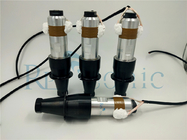
loading
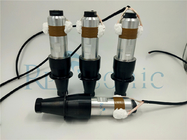

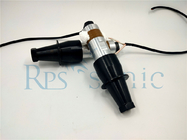

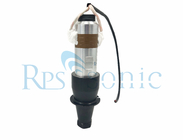

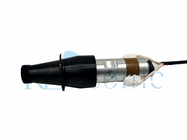

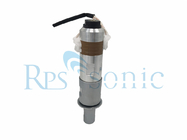

| Place of Origin | China |
|---|---|
| Brand Name | Rps-sonic |
| Certification | CE |
| Model Number | RPS-5020-4Z |
| Minimum Order Quantity | 1pcs |
| Price | negotiable |
| Packaging Details | CARTON |
| Delivery Time | 1DAYS |
| Payment Terms | T/T |
| Supply Ability | 200PCS/MONTH |
| Frequency | 20Khz | Power | 2000w |
|---|---|---|---|
| Ceramic Chips | 4PCS | Material | Alumium |
| Weight | 3.5kg | Application | Ultrasonic Welding |
| Capacitance | 11000~12000PF | Connect Screw | M8*1.5 |
| High Light | 4PCS Ceramic Chips Ultrasonic Welding Transducer,20 Khz Mask Welding Transducer,Mask Ultrasonic Welding Transducer | ||
20Khz Ultrasonic welding transducer with booster for mask welding machine
Parameter
| Item | Frequency | Impedance | Capacitance |
| 5020-4Z | 19.8 | 6 | 12000 |
Description
So what is this ultrasonic process about? The process is simple: an ultrasound converter changes the electrical signal which is produced by a generator into mechanical vibrations. The vibrations are then transmitted to the workpiece to be welded, the nonwovens in this case, via the booster and the sonotrode through a specific pressure. This will in turn generate a frictional heat and lead the material to melt and bond the part together.
Ultrasonic welding is a reliable, productive, cost-effective and safe process. Welding of nonwovens with ultrasound guarantees soft and flexible surfaces, as there is no radiant heat during welding so no risk of hardening can occur. The energy is used precisely and in a targeted manner so that web materials do not become warped. There is also no need for adhesives or glue, so there is no risk of having adhesive residues build up on rollers and pulleys in production. It is a much cleaner process.
Another advantage is speed. As ultrasonic energy reduces friction, it increases production speeds, and can lead to welding of web materials at over 600 m per minute. In these times of mask shortage, this is an incredible advantage.
Temperatures also stay low despite long process times, unlike thermal processes where the tools are continuously heated and can lead to fire risks.
Ultrasound welding is suited for the mass production of all types of mouth and respiratory protection masks, such as surgical masks.
Nonwoven Fabrics + Ultrasonic Welding = Face Masks for the World
The low cost and utility of nonwoven fabrics have made them essential in the global battle to prevent the spread of infection. When built into PPE such as medical face masks, gowns and scrubs, and even foot covers, disposable nonwovens can provide effective and inexpensive protection against microorganisms. The key to their effectiveness is in multilayer construction, which combines an inner layer weighing 10 to 25 grams per square meter (g/m2), an outer layer of spunbond polypropylene (PP) weighing 25 to 40 g/m2, and a middle layer typically 25 g/m2 of meltblown PP fibers.
The ultrasonic welding equipment that is essential to the production of medical-grade face masks and respirators is often, but not always, embedded within larger, fully automated mask-production machines. These machines typically are fed by two or three rolls of nonwoven material — the inner, middle and outer layers — which are processed continuously.
Simply explained, ultrasonic welders convert electrical energy to high-frequency mechanical vibration, which is transmitted using tooling into thermoplastic material. The vibration creates frictional heat that melts the plastic, an operation that can be focused and utilized to:
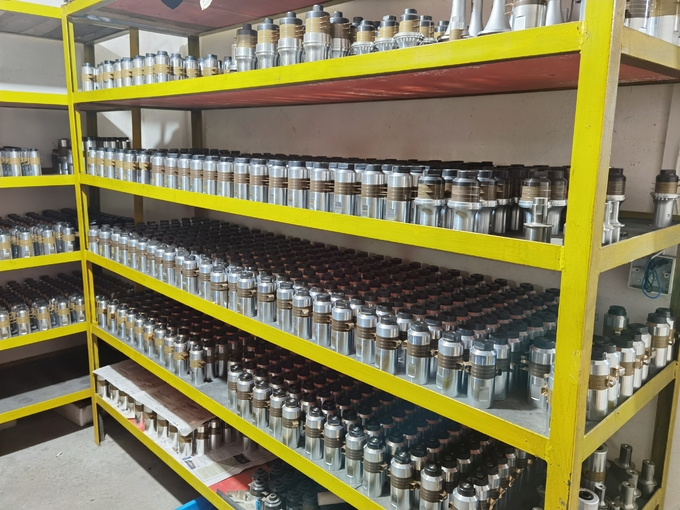
| Frequency | 20Khz | Power | 2000w |
|---|---|---|---|
| Ceramic Chips | 4PCS | Material | Alumium |
| Weight | 3.5kg | Application | Ultrasonic Welding |
| Capacitance | 11000~12000PF | Connect Screw | M8*1.5 |
| High Light | 4PCS Ceramic Chips Ultrasonic Welding Transducer,20 Khz Mask Welding Transducer,Mask Ultrasonic Welding Transducer | ||
20Khz Ultrasonic welding transducer with booster for mask welding machine
Parameter
| Item | Frequency | Impedance | Capacitance |
| 5020-4Z | 19.8 | 6 | 12000 |
Description
So what is this ultrasonic process about? The process is simple: an ultrasound converter changes the electrical signal which is produced by a generator into mechanical vibrations. The vibrations are then transmitted to the workpiece to be welded, the nonwovens in this case, via the booster and the sonotrode through a specific pressure. This will in turn generate a frictional heat and lead the material to melt and bond the part together.
Ultrasonic welding is a reliable, productive, cost-effective and safe process. Welding of nonwovens with ultrasound guarantees soft and flexible surfaces, as there is no radiant heat during welding so no risk of hardening can occur. The energy is used precisely and in a targeted manner so that web materials do not become warped. There is also no need for adhesives or glue, so there is no risk of having adhesive residues build up on rollers and pulleys in production. It is a much cleaner process.
Another advantage is speed. As ultrasonic energy reduces friction, it increases production speeds, and can lead to welding of web materials at over 600 m per minute. In these times of mask shortage, this is an incredible advantage.
Temperatures also stay low despite long process times, unlike thermal processes where the tools are continuously heated and can lead to fire risks.
Ultrasound welding is suited for the mass production of all types of mouth and respiratory protection masks, such as surgical masks.
Nonwoven Fabrics + Ultrasonic Welding = Face Masks for the World
The low cost and utility of nonwoven fabrics have made them essential in the global battle to prevent the spread of infection. When built into PPE such as medical face masks, gowns and scrubs, and even foot covers, disposable nonwovens can provide effective and inexpensive protection against microorganisms. The key to their effectiveness is in multilayer construction, which combines an inner layer weighing 10 to 25 grams per square meter (g/m2), an outer layer of spunbond polypropylene (PP) weighing 25 to 40 g/m2, and a middle layer typically 25 g/m2 of meltblown PP fibers.
The ultrasonic welding equipment that is essential to the production of medical-grade face masks and respirators is often, but not always, embedded within larger, fully automated mask-production machines. These machines typically are fed by two or three rolls of nonwoven material — the inner, middle and outer layers — which are processed continuously.
Simply explained, ultrasonic welders convert electrical energy to high-frequency mechanical vibration, which is transmitted using tooling into thermoplastic material. The vibration creates frictional heat that melts the plastic, an operation that can be focused and utilized to:









Ultrasonic Welding Equipment Ultrasonic Welding Transducer Ultrasonic Welding Converter Ultrasonic Liquid Processor Ultrasonic Cutting Equipment Ultrasonic Spray Nozzles Ultrasonic Power Supply Ultrasonic Soldering Equipment Ultrasonic Welding Horn Ultrasonic Assisted Machining Ultrasonic Testing Equipment
content is empty!